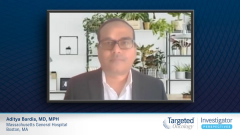
The EMERALD Trial: Elacestrant Mechanism of Action, Study Design, and Outcomes
Dr Bardia discusses the mechanism of action of elacestrant, how elacestrant compares to other SERDS, and introduces the EMERALD trial.
Dr. Aditya Bardia: Elacestrant is a novel selective estrogen receptor degrader. It's oral. The drug binds to the estrogen receptor, blocks it and degrades it. In a phase 1/2 clinical trial that we were involved with, we could see evidence of clinical activity in pretreated patients with ER-positive HER2-negative metastatic breast cancer. Subset analysis revealed that patients who have ESR1 mutant metastatic breast cancer, you could clearly see activity with Elacestrant. This led to the design of the phase 3 trial, the EMERALD trial that looked at Elacestrant versus standard-of-care endocrine therapy in the second third-line setting for patients with ER-positive HER2-negative metastatic breast cancer. There are three features I would like to highlight related to the study design. The first is that it was a randomized global phase 3 trial in multiple regions so it was important to consider the practice patterns in different countries. The second is that the trial required patients to have prior CDK4/6 inhibitor because that's what we use in the first-line setting. That was required in this trial. Then the third is that the trial had two primary endpoints and was powered for both the primary endpoints. The first one was progression-free survival of Elacestrant was a standard of care endocrine therapy which would either be fulvestrant or aromatase inhibitor in patients who have ESR1 mutant metastatic breast cancer. A second primary endpoint was in all comers regardless of ESR1 mutations, progression-free survival with Elacestrant versus standard-of-care endocrine therapy.
Elacestrant is a selective estrogen receptor degrader. Besides Elacestrant, there are other selective estrogen receptor degraders example being giredestrant, camizestrant. These are all agents that bind to the estrogen receptor and degrade it. There are also SERMs or selective estrogen receptor modulators. Example being tamoxifen, also interest in a new SERM called lasofoxifene. Those are agents that bind to the estrogen receptor but do not degrade it per se, but they can modulate the function of the estrogen receptor. In clinical trials, we've seen data from different selective estrogen receptor degraders including the second, third-line setting. The EMERALD trial evaluating Elacestrant was positive. It showed improvement in progression-free survival and a trend towards improvement in overall survival as well. Elacestrant was a standard of care endocrine therapy, but we've also seen two negative studies. The first one was AMEERA03 which looked at amcenestrant was a standard of care endocrine therapy in the second-line and third-line setting, although was predominantly second-line. The second trial with acelERA which looked at giredestrant was a standard of care endocrine therapy in the second third-line setting for patients with ER-positive HER2-negative metastatic breast cancer. It should be noted that there were differences in the study design between these three trials. EMERALD, acelERA, as well as AMEERA03 in terms of the second third-line setting, in terms of the proportion of patients who got fulvestrant, the use of prior CDK4/6 inhibitor and perhaps most important, the proportion of patients who had ESR1 mutations. Only EMERALD had two primary endpoints looking at overall population as well as population of patients who had ESR1 mutant metastatic breast cancer. This was not a primary endpoint, the ESR1 mutant group in either EMERALD or acelERA.








































